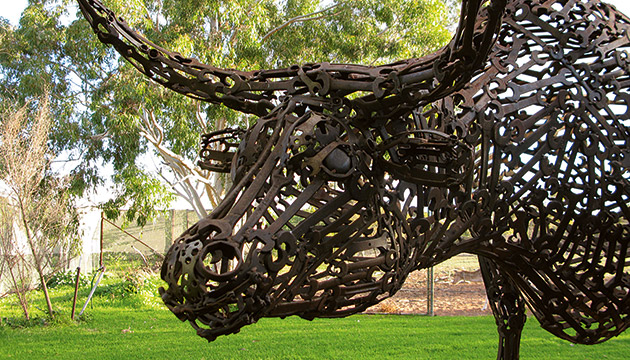From his wheelchair, successful Mallee farmer John Piccoli welds old spanners into life-size works of art.
Story By Jenny Lanyon
Wheat and sheep are common fare in the Mallee country of northern Victoria but there is something obviously different about John Piccoli’s property. From his motorised wheelchair John is shifting sprinklers after a morning’s work in the garden, his work-clothes carrying a dusting of concrete. Surrounding him, and gracing the homestead gardens, is a multitude of sculptures: a buckjumper, a charging bull and stallions clashing in combat. Each is life-size and created by John from old spanners. In the distance, alpacas and deer stare from the home paddock, while a macaw squawks from the verandah. Clearly this is no ordinary farming enterprise.
John’s grandfather was lured from Switzerland to Australia by gold in 1875. Prospecting, he worked his way through Ballarat and Bendigo in Victoria on foot, later selecting a traditional 130-hectare block north of Boort, Vic, which he soon built up to 1200ha.
John has farmed wheat and sheep here all his life, apart from three years when he was confined to a hospital bed. In the early 1950s he contracted polio at the tender age of eight. The disease left him without the use of his legs.
“Dryland farming has always been a knife-edge living,” John says. “You try to keep your head above water when times aren’t so good. I’ve always looked for alternatives on the farm, to give me another string to the bow. I’ve been through quite a few: angora goats, deer, ostriches, Wagyu cattle and now macaws.”
However, at the age of 58 and after three bad drought years in the late 1990s, John decided to sell his stock and lease the bulk of the property to his neighbours. “With that decision made, I no longer had to worry about farming,” John says. “My wife Sonia and I were debating our next move. While cleaning up what had accumulated in the farm workshop over 130 years, we threw dusty, old spanners into a box under the bench. I soon had hundreds and that’s when I started thinking outside the square, creating sculptures. Once my hands were free I started to weld them up.” It was a turning point in John’s life and one from which he has not looked back.
This story excerpt is from Issue #80
Outback Magazine: Dec/Jan 2012










